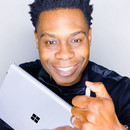An AI PC Built for Businesses
Much like the advent of smartphones or cloud computing, AI represents a generational shift. It’s changing the way companies work and accelerating operational tasks. But it’s also creating new opportunities concerning how humans interact with machines
Windows Studio Effects, a set of AI-powered video and audio enhancements designed to improve the quality of video calls and recordings, is one such example that’s changing how users collaborate in hybrid work environments, Walker says. Driven by onboard NPUs, it keeps users in the center of the screen with automatic framing, helps to cancel out background noise with voice focus, keeps the focus on the user with background blur and adjusts the users gaze to simulate eye contact.
“You can be speaking with a colleague and have all the sound behind you suppressed,” Walker says. “I can be in a coffee shop or working outside, but it doesn’t affect the quality of my calls.”
RELATED: Microsoft's Surface devices give users CoPilot AI at their fingertips.
AI Inside: The Cutting-Edge NPU Processor
Much like CPUs or graphics processing units, NPUs are part of processor chipsets. These neural processing units are designed to manage and optimize AI-intensive tasks, such as automatically tracking user movements or creating captions for meetings in progress.
Both the Surface Pro 10 and the Surface Laptop 6 feature an NPU with 11 trillion operations per second along with 18 TOPS for the GPU and 5 TOPS for the CPU. The Intel AI Boost also doesn’t rely on the NPU alone; it uses CPU, GPU, and NPU resources simultaneously to optimize performance.
For example, applications that require more speed will leverage the 16 cores and 5-gigahertz turbo frequency of the Intel Core Ultra 165H (on the Surface Laptop 6), or the 12 cores and 4.9GHz turbo frequency of the 165U (on the Surface Pro 10).
DISCOVER: Why the Intel Core processor boosts everyday productivity.
Windows Studio Effects is a prime example of the NPU in action, Perry says. Its capabilities include 114-degree automatic framing, eye tracking and voice focus. With the NPU running, CPU activity hovered around 25 percent. Disable the NPU and you’ll experience a massive spike in CPU usage.
“With AI on the hardware itself, you have the ability to reduce friction in your workflow and be productive no matter where you are,” Perry says.
AI in the Cloud: Microsoft Copilot
The Surface Pro 10 and Surface Laptop 6 also give users access to powerful AI in the cloud with Microsoft Copilot.
With a dedicated Copilot key, it’s simple for staff to streamline their workflows with personalized support and contextual assistance. Users can engage with Copilot through touch, by using their keyboards or with their voices — whatever is most convenient.












